Leadership and Operations Management Report: Marks & Spencer
VerifiedAdded on 2021/01/03
|13
|4026
|51
Report
AI Summary
This report provides an in-depth analysis of leadership and management practices within Marks and Spencer, a multinational retailer. It begins by differentiating the roles and characteristics of leaders and managers, emphasizing their importance in achieving organizational goals. The report then explores how leaders and managers handle various situations, including decision-making and employee engagement, and highlights potential workplace conflicts. It delves into the application of leadership theories such as situational, contingency, and system leadership, illustrating their strengths and weaknesses within the context of Marks and Spencer. Furthermore, the report examines key approaches to operations management, including Six Sigma, Just-in-Time, and continuous improvement, and the roles leaders and managers play in their implementation. Finally, it discusses the impact of internal factors on operational management and decision-making, offering a comprehensive overview of the subject.
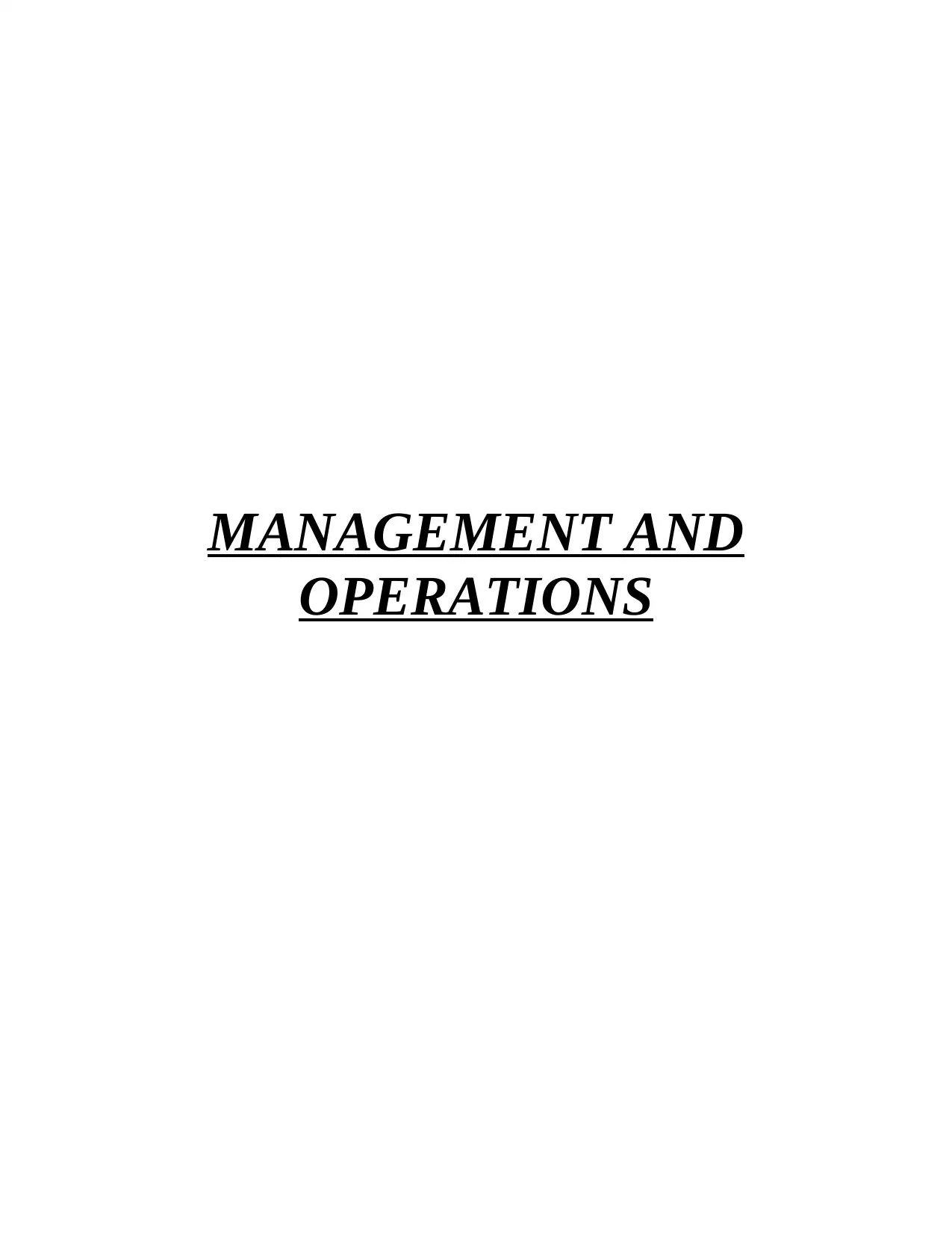
MANAGEMENT AND
OPERATIONS
OPERATIONS
Paraphrase This Document
Need a fresh take? Get an instant paraphrase of this document with our AI Paraphraser
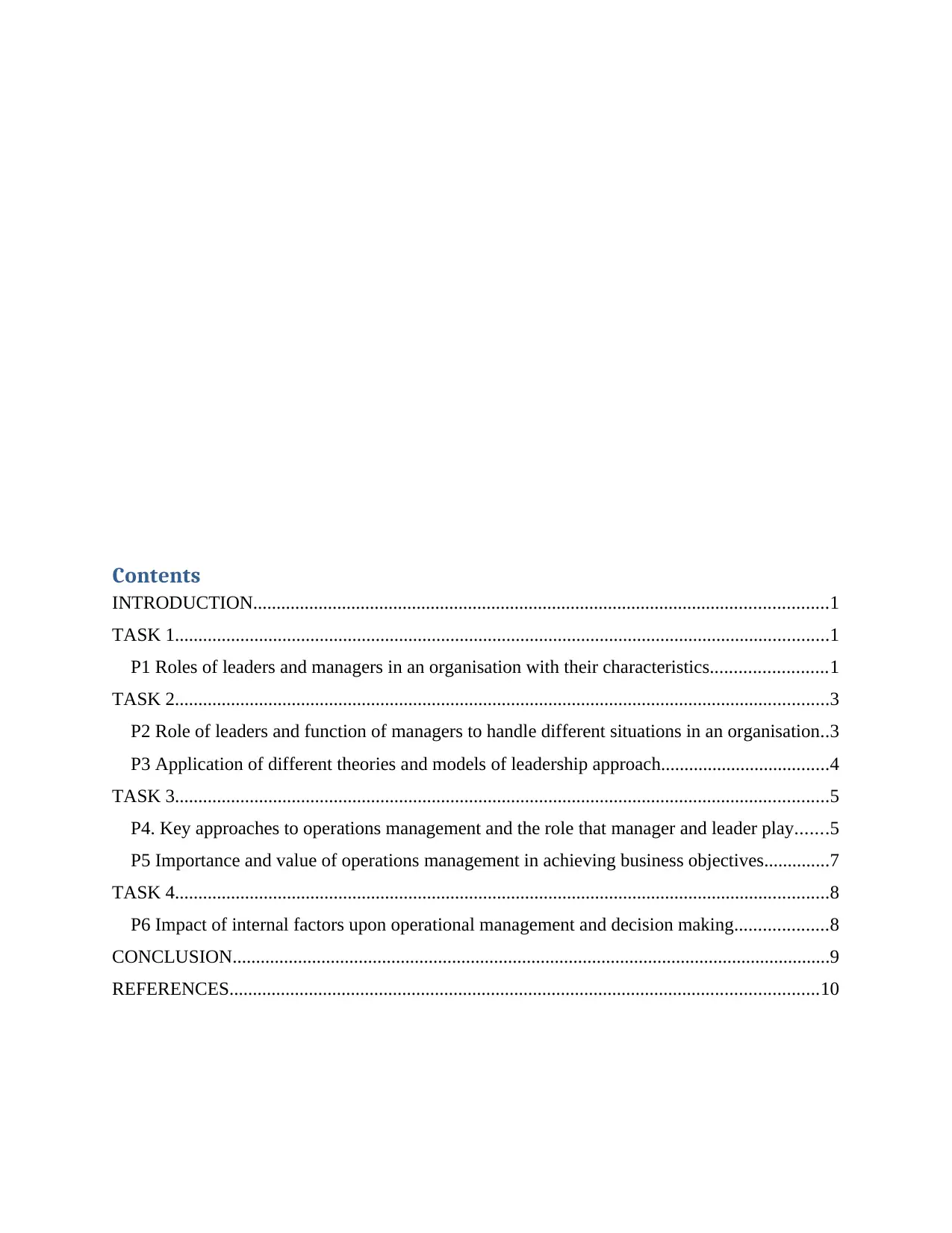
Contents
INTRODUCTION...........................................................................................................................1
TASK 1............................................................................................................................................1
P1 Roles of leaders and managers in an organisation with their characteristics.........................1
TASK 2............................................................................................................................................3
P2 Role of leaders and function of managers to handle different situations in an organisation..3
P3 Application of different theories and models of leadership approach....................................4
TASK 3............................................................................................................................................5
P4. Key approaches to operations management and the role that manager and leader play.......5
P5 Importance and value of operations management in achieving business objectives..............7
TASK 4............................................................................................................................................8
P6 Impact of internal factors upon operational management and decision making....................8
CONCLUSION................................................................................................................................9
REFERENCES..............................................................................................................................10
INTRODUCTION...........................................................................................................................1
TASK 1............................................................................................................................................1
P1 Roles of leaders and managers in an organisation with their characteristics.........................1
TASK 2............................................................................................................................................3
P2 Role of leaders and function of managers to handle different situations in an organisation..3
P3 Application of different theories and models of leadership approach....................................4
TASK 3............................................................................................................................................5
P4. Key approaches to operations management and the role that manager and leader play.......5
P5 Importance and value of operations management in achieving business objectives..............7
TASK 4............................................................................................................................................8
P6 Impact of internal factors upon operational management and decision making....................8
CONCLUSION................................................................................................................................9
REFERENCES..............................................................................................................................10
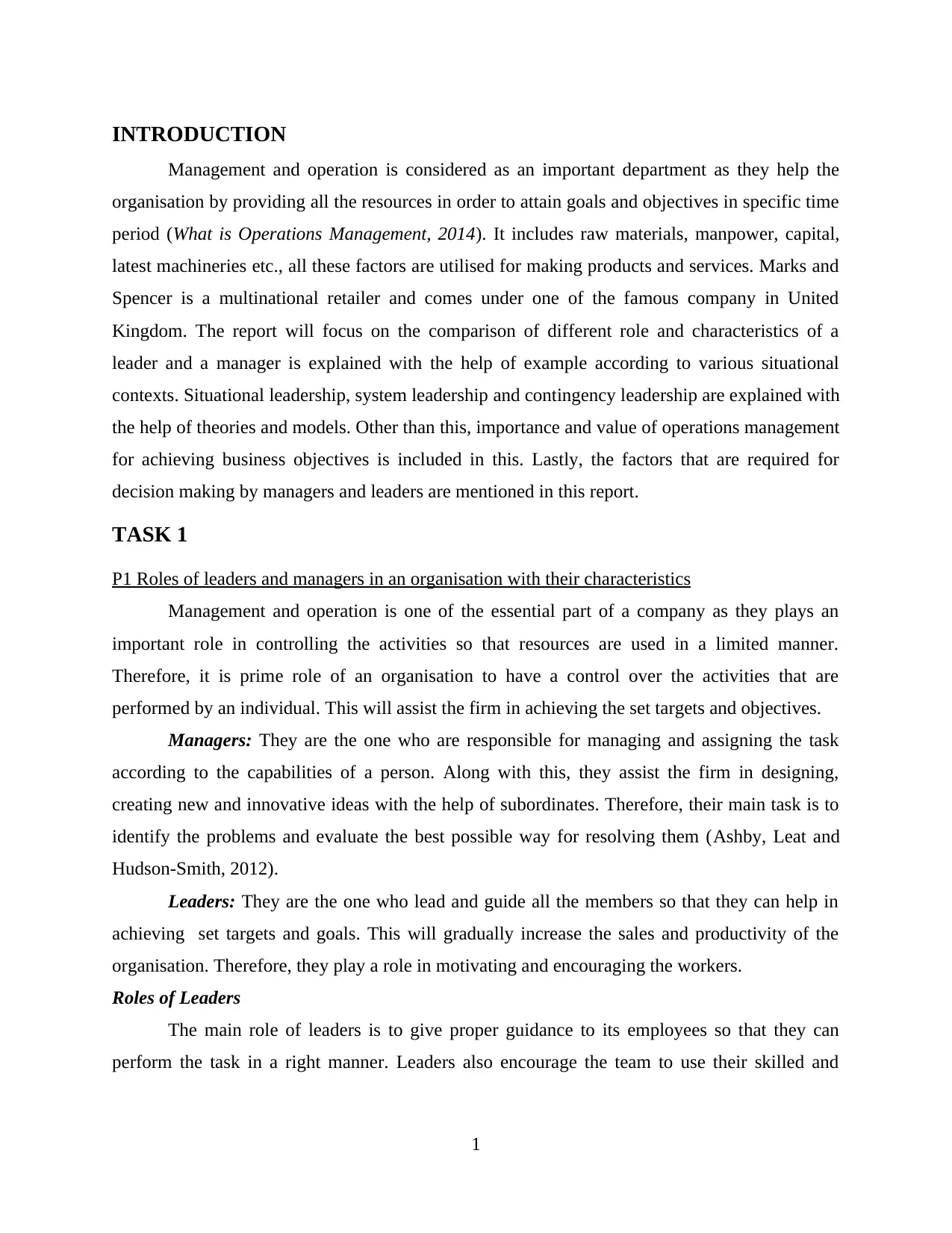
INTRODUCTION
Management and operation is considered as an important department as they help the
organisation by providing all the resources in order to attain goals and objectives in specific time
period (What is Operations Management, 2014). It includes raw materials, manpower, capital,
latest machineries etc., all these factors are utilised for making products and services. Marks and
Spencer is a multinational retailer and comes under one of the famous company in United
Kingdom. The report will focus on the comparison of different role and characteristics of a
leader and a manager is explained with the help of example according to various situational
contexts. Situational leadership, system leadership and contingency leadership are explained with
the help of theories and models. Other than this, importance and value of operations management
for achieving business objectives is included in this. Lastly, the factors that are required for
decision making by managers and leaders are mentioned in this report.
TASK 1
P1 Roles of leaders and managers in an organisation with their characteristics
Management and operation is one of the essential part of a company as they plays an
important role in controlling the activities so that resources are used in a limited manner.
Therefore, it is prime role of an organisation to have a control over the activities that are
performed by an individual. This will assist the firm in achieving the set targets and objectives.
Managers: They are the one who are responsible for managing and assigning the task
according to the capabilities of a person. Along with this, they assist the firm in designing,
creating new and innovative ideas with the help of subordinates. Therefore, their main task is to
identify the problems and evaluate the best possible way for resolving them (Ashby, Leat and
Hudson-Smith, 2012).
Leaders: They are the one who lead and guide all the members so that they can help in
achieving set targets and goals. This will gradually increase the sales and productivity of the
organisation. Therefore, they play a role in motivating and encouraging the workers.
Roles of Leaders
The main role of leaders is to give proper guidance to its employees so that they can
perform the task in a right manner. Leaders also encourage the team to use their skilled and
1
Management and operation is considered as an important department as they help the
organisation by providing all the resources in order to attain goals and objectives in specific time
period (What is Operations Management, 2014). It includes raw materials, manpower, capital,
latest machineries etc., all these factors are utilised for making products and services. Marks and
Spencer is a multinational retailer and comes under one of the famous company in United
Kingdom. The report will focus on the comparison of different role and characteristics of a
leader and a manager is explained with the help of example according to various situational
contexts. Situational leadership, system leadership and contingency leadership are explained with
the help of theories and models. Other than this, importance and value of operations management
for achieving business objectives is included in this. Lastly, the factors that are required for
decision making by managers and leaders are mentioned in this report.
TASK 1
P1 Roles of leaders and managers in an organisation with their characteristics
Management and operation is one of the essential part of a company as they plays an
important role in controlling the activities so that resources are used in a limited manner.
Therefore, it is prime role of an organisation to have a control over the activities that are
performed by an individual. This will assist the firm in achieving the set targets and objectives.
Managers: They are the one who are responsible for managing and assigning the task
according to the capabilities of a person. Along with this, they assist the firm in designing,
creating new and innovative ideas with the help of subordinates. Therefore, their main task is to
identify the problems and evaluate the best possible way for resolving them (Ashby, Leat and
Hudson-Smith, 2012).
Leaders: They are the one who lead and guide all the members so that they can help in
achieving set targets and goals. This will gradually increase the sales and productivity of the
organisation. Therefore, they play a role in motivating and encouraging the workers.
Roles of Leaders
The main role of leaders is to give proper guidance to its employees so that they can
perform the task in a right manner. Leaders also encourage the team to use their skilled and
1
⊘ This is a preview!⊘
Do you want full access?
Subscribe today to unlock all pages.

Trusted by 1+ million students worldwide
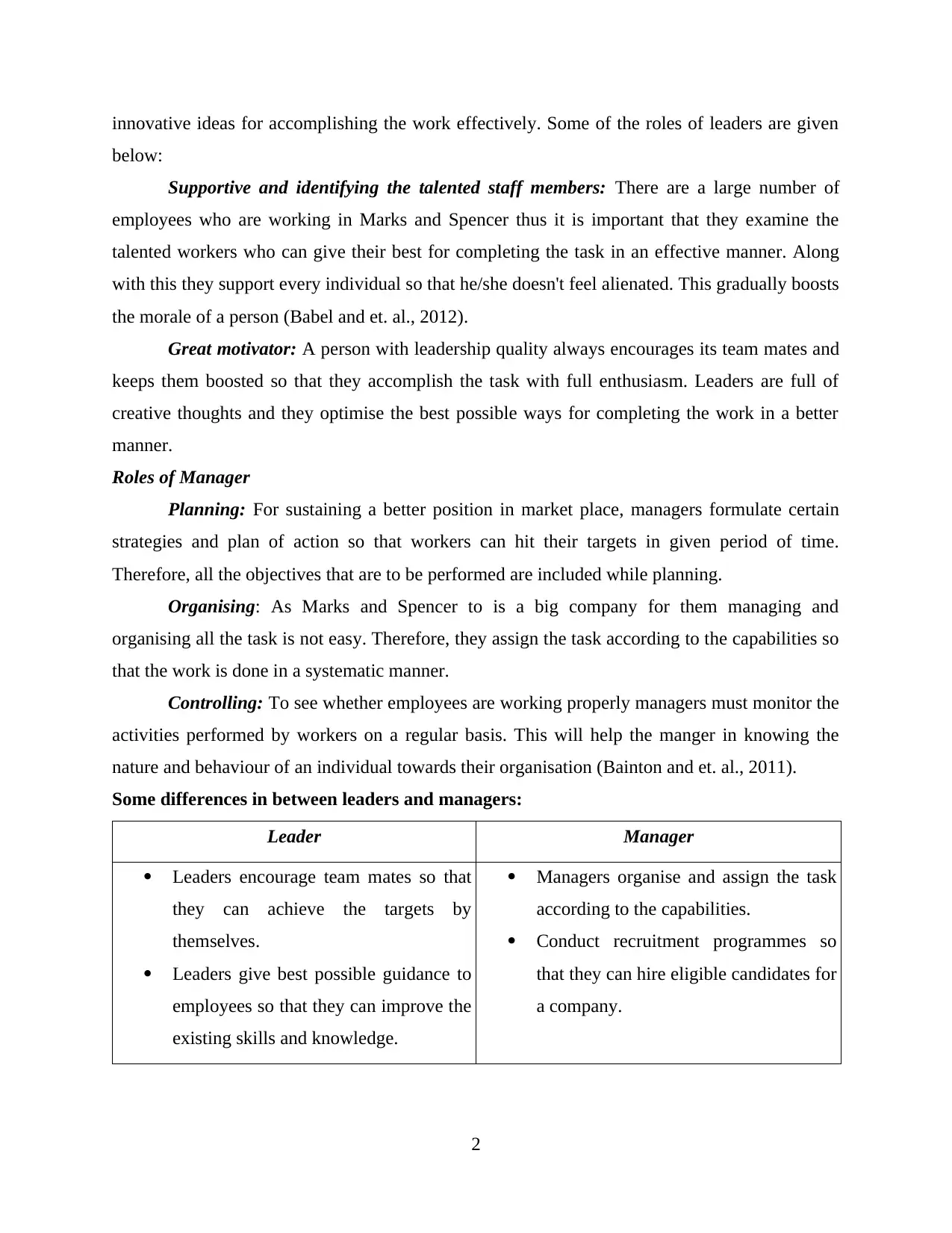
innovative ideas for accomplishing the work effectively. Some of the roles of leaders are given
below:
Supportive and identifying the talented staff members: There are a large number of
employees who are working in Marks and Spencer thus it is important that they examine the
talented workers who can give their best for completing the task in an effective manner. Along
with this they support every individual so that he/she doesn't feel alienated. This gradually boosts
the morale of a person (Babel and et. al., 2012).
Great motivator: A person with leadership quality always encourages its team mates and
keeps them boosted so that they accomplish the task with full enthusiasm. Leaders are full of
creative thoughts and they optimise the best possible ways for completing the work in a better
manner.
Roles of Manager
Planning: For sustaining a better position in market place, managers formulate certain
strategies and plan of action so that workers can hit their targets in given period of time.
Therefore, all the objectives that are to be performed are included while planning.
Organising: As Marks and Spencer to is a big company for them managing and
organising all the task is not easy. Therefore, they assign the task according to the capabilities so
that the work is done in a systematic manner.
Controlling: To see whether employees are working properly managers must monitor the
activities performed by workers on a regular basis. This will help the manger in knowing the
nature and behaviour of an individual towards their organisation (Bainton and et. al., 2011).
Some differences in between leaders and managers:
Leader Manager
Leaders encourage team mates so that
they can achieve the targets by
themselves.
Leaders give best possible guidance to
employees so that they can improve the
existing skills and knowledge.
Managers organise and assign the task
according to the capabilities.
Conduct recruitment programmes so
that they can hire eligible candidates for
a company.
2
below:
Supportive and identifying the talented staff members: There are a large number of
employees who are working in Marks and Spencer thus it is important that they examine the
talented workers who can give their best for completing the task in an effective manner. Along
with this they support every individual so that he/she doesn't feel alienated. This gradually boosts
the morale of a person (Babel and et. al., 2012).
Great motivator: A person with leadership quality always encourages its team mates and
keeps them boosted so that they accomplish the task with full enthusiasm. Leaders are full of
creative thoughts and they optimise the best possible ways for completing the work in a better
manner.
Roles of Manager
Planning: For sustaining a better position in market place, managers formulate certain
strategies and plan of action so that workers can hit their targets in given period of time.
Therefore, all the objectives that are to be performed are included while planning.
Organising: As Marks and Spencer to is a big company for them managing and
organising all the task is not easy. Therefore, they assign the task according to the capabilities so
that the work is done in a systematic manner.
Controlling: To see whether employees are working properly managers must monitor the
activities performed by workers on a regular basis. This will help the manger in knowing the
nature and behaviour of an individual towards their organisation (Bainton and et. al., 2011).
Some differences in between leaders and managers:
Leader Manager
Leaders encourage team mates so that
they can achieve the targets by
themselves.
Leaders give best possible guidance to
employees so that they can improve the
existing skills and knowledge.
Managers organise and assign the task
according to the capabilities.
Conduct recruitment programmes so
that they can hire eligible candidates for
a company.
2
Paraphrase This Document
Need a fresh take? Get an instant paraphrase of this document with our AI Paraphraser
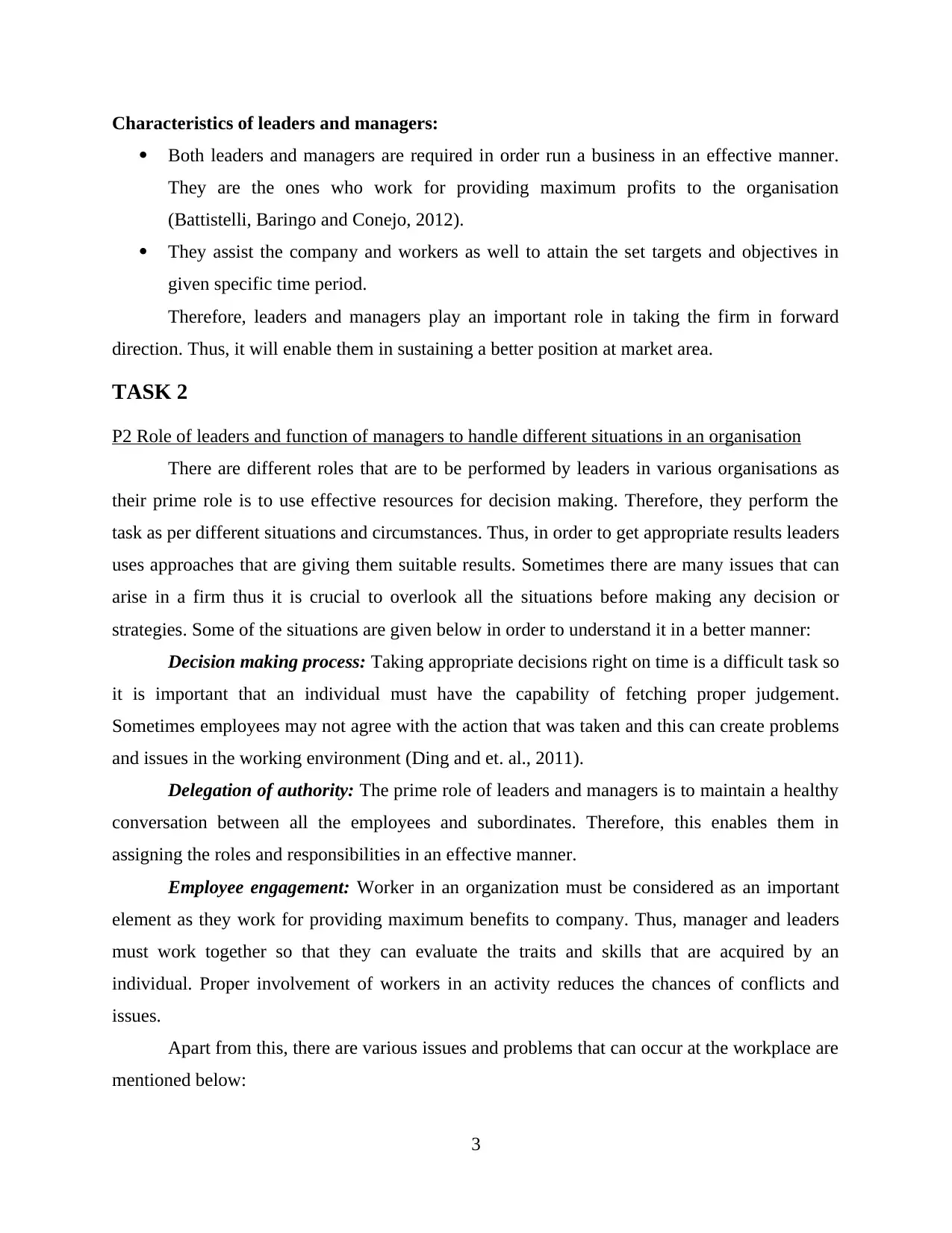
Characteristics of leaders and managers:
Both leaders and managers are required in order run a business in an effective manner.
They are the ones who work for providing maximum profits to the organisation
(Battistelli, Baringo and Conejo, 2012).
They assist the company and workers as well to attain the set targets and objectives in
given specific time period.
Therefore, leaders and managers play an important role in taking the firm in forward
direction. Thus, it will enable them in sustaining a better position at market area.
TASK 2
P2 Role of leaders and function of managers to handle different situations in an organisation
There are different roles that are to be performed by leaders in various organisations as
their prime role is to use effective resources for decision making. Therefore, they perform the
task as per different situations and circumstances. Thus, in order to get appropriate results leaders
uses approaches that are giving them suitable results. Sometimes there are many issues that can
arise in a firm thus it is crucial to overlook all the situations before making any decision or
strategies. Some of the situations are given below in order to understand it in a better manner:
Decision making process: Taking appropriate decisions right on time is a difficult task so
it is important that an individual must have the capability of fetching proper judgement.
Sometimes employees may not agree with the action that was taken and this can create problems
and issues in the working environment (Ding and et. al., 2011).
Delegation of authority: The prime role of leaders and managers is to maintain a healthy
conversation between all the employees and subordinates. Therefore, this enables them in
assigning the roles and responsibilities in an effective manner.
Employee engagement: Worker in an organization must be considered as an important
element as they work for providing maximum benefits to company. Thus, manager and leaders
must work together so that they can evaluate the traits and skills that are acquired by an
individual. Proper involvement of workers in an activity reduces the chances of conflicts and
issues.
Apart from this, there are various issues and problems that can occur at the workplace are
mentioned below:
3
Both leaders and managers are required in order run a business in an effective manner.
They are the ones who work for providing maximum profits to the organisation
(Battistelli, Baringo and Conejo, 2012).
They assist the company and workers as well to attain the set targets and objectives in
given specific time period.
Therefore, leaders and managers play an important role in taking the firm in forward
direction. Thus, it will enable them in sustaining a better position at market area.
TASK 2
P2 Role of leaders and function of managers to handle different situations in an organisation
There are different roles that are to be performed by leaders in various organisations as
their prime role is to use effective resources for decision making. Therefore, they perform the
task as per different situations and circumstances. Thus, in order to get appropriate results leaders
uses approaches that are giving them suitable results. Sometimes there are many issues that can
arise in a firm thus it is crucial to overlook all the situations before making any decision or
strategies. Some of the situations are given below in order to understand it in a better manner:
Decision making process: Taking appropriate decisions right on time is a difficult task so
it is important that an individual must have the capability of fetching proper judgement.
Sometimes employees may not agree with the action that was taken and this can create problems
and issues in the working environment (Ding and et. al., 2011).
Delegation of authority: The prime role of leaders and managers is to maintain a healthy
conversation between all the employees and subordinates. Therefore, this enables them in
assigning the roles and responsibilities in an effective manner.
Employee engagement: Worker in an organization must be considered as an important
element as they work for providing maximum benefits to company. Thus, manager and leaders
must work together so that they can evaluate the traits and skills that are acquired by an
individual. Proper involvement of workers in an activity reduces the chances of conflicts and
issues.
Apart from this, there are various issues and problems that can occur at the workplace are
mentioned below:
3
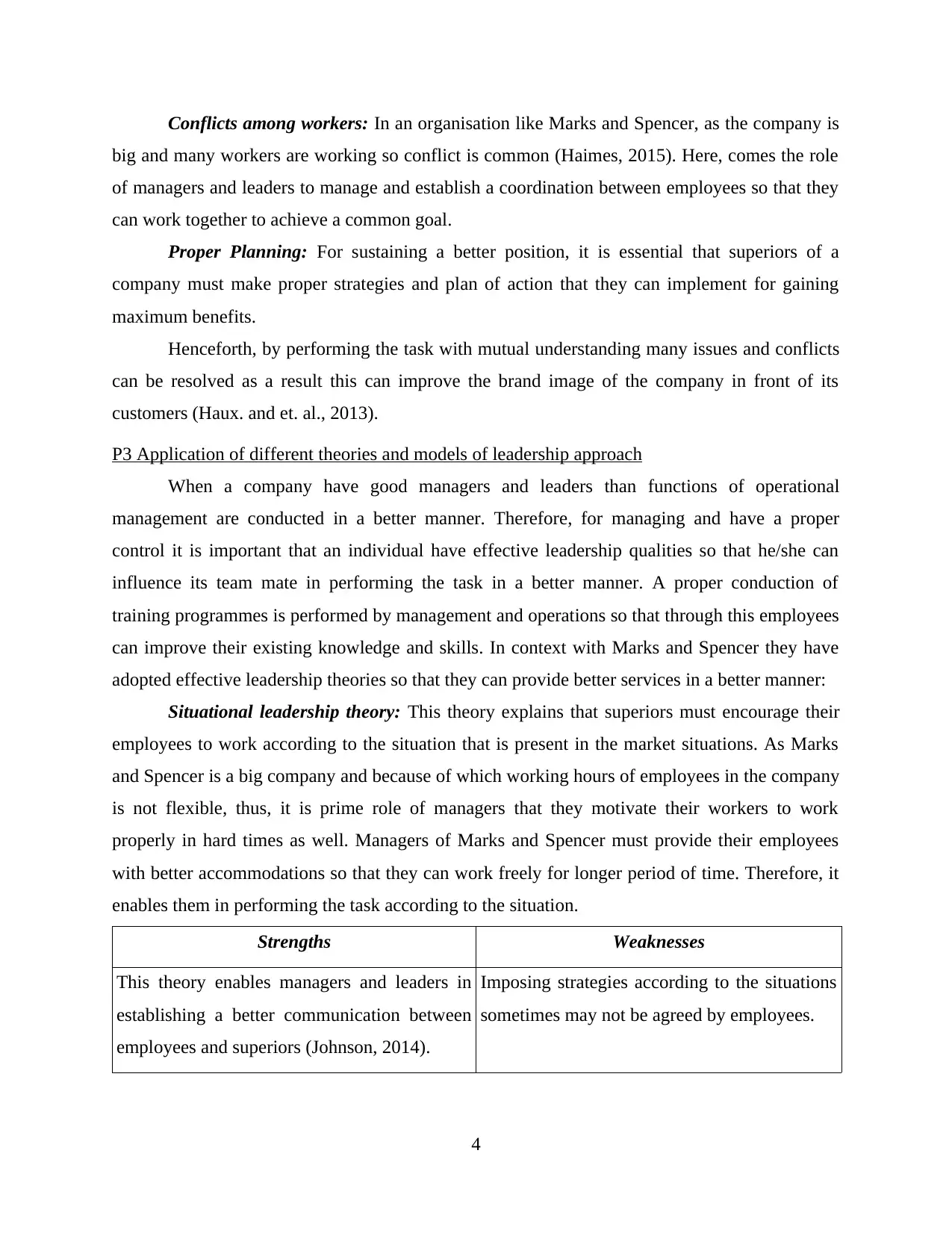
Conflicts among workers: In an organisation like Marks and Spencer, as the company is
big and many workers are working so conflict is common (Haimes, 2015). Here, comes the role
of managers and leaders to manage and establish a coordination between employees so that they
can work together to achieve a common goal.
Proper Planning: For sustaining a better position, it is essential that superiors of a
company must make proper strategies and plan of action that they can implement for gaining
maximum benefits.
Henceforth, by performing the task with mutual understanding many issues and conflicts
can be resolved as a result this can improve the brand image of the company in front of its
customers (Haux. and et. al., 2013).
P3 Application of different theories and models of leadership approach
When a company have good managers and leaders than functions of operational
management are conducted in a better manner. Therefore, for managing and have a proper
control it is important that an individual have effective leadership qualities so that he/she can
influence its team mate in performing the task in a better manner. A proper conduction of
training programmes is performed by management and operations so that through this employees
can improve their existing knowledge and skills. In context with Marks and Spencer they have
adopted effective leadership theories so that they can provide better services in a better manner:
Situational leadership theory: This theory explains that superiors must encourage their
employees to work according to the situation that is present in the market situations. As Marks
and Spencer is a big company and because of which working hours of employees in the company
is not flexible, thus, it is prime role of managers that they motivate their workers to work
properly in hard times as well. Managers of Marks and Spencer must provide their employees
with better accommodations so that they can work freely for longer period of time. Therefore, it
enables them in performing the task according to the situation.
Strengths Weaknesses
This theory enables managers and leaders in
establishing a better communication between
employees and superiors (Johnson, 2014).
Imposing strategies according to the situations
sometimes may not be agreed by employees.
4
big and many workers are working so conflict is common (Haimes, 2015). Here, comes the role
of managers and leaders to manage and establish a coordination between employees so that they
can work together to achieve a common goal.
Proper Planning: For sustaining a better position, it is essential that superiors of a
company must make proper strategies and plan of action that they can implement for gaining
maximum benefits.
Henceforth, by performing the task with mutual understanding many issues and conflicts
can be resolved as a result this can improve the brand image of the company in front of its
customers (Haux. and et. al., 2013).
P3 Application of different theories and models of leadership approach
When a company have good managers and leaders than functions of operational
management are conducted in a better manner. Therefore, for managing and have a proper
control it is important that an individual have effective leadership qualities so that he/she can
influence its team mate in performing the task in a better manner. A proper conduction of
training programmes is performed by management and operations so that through this employees
can improve their existing knowledge and skills. In context with Marks and Spencer they have
adopted effective leadership theories so that they can provide better services in a better manner:
Situational leadership theory: This theory explains that superiors must encourage their
employees to work according to the situation that is present in the market situations. As Marks
and Spencer is a big company and because of which working hours of employees in the company
is not flexible, thus, it is prime role of managers that they motivate their workers to work
properly in hard times as well. Managers of Marks and Spencer must provide their employees
with better accommodations so that they can work freely for longer period of time. Therefore, it
enables them in performing the task according to the situation.
Strengths Weaknesses
This theory enables managers and leaders in
establishing a better communication between
employees and superiors (Johnson, 2014).
Imposing strategies according to the situations
sometimes may not be agreed by employees.
4
⊘ This is a preview!⊘
Do you want full access?
Subscribe today to unlock all pages.

Trusted by 1+ million students worldwide
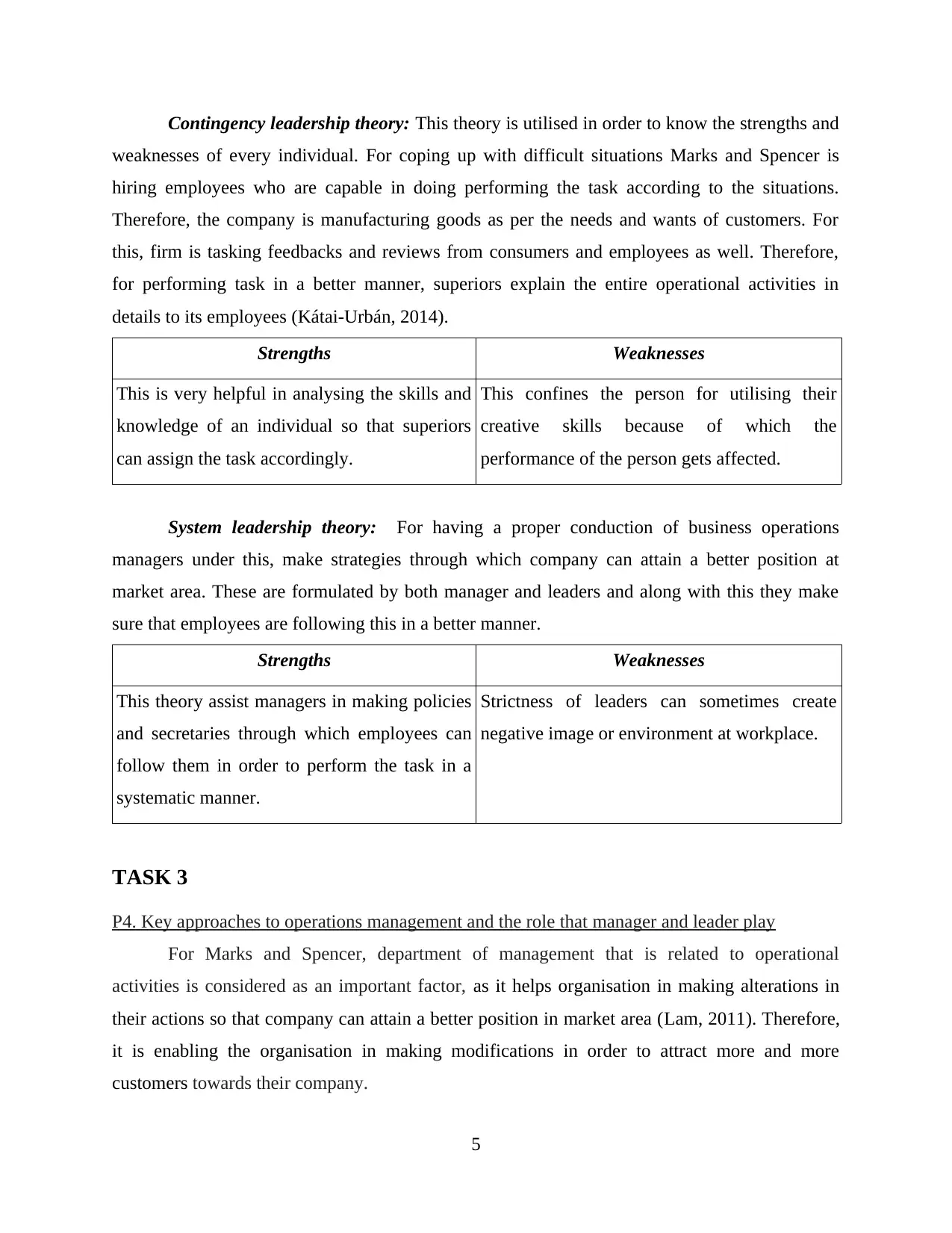
Contingency leadership theory: This theory is utilised in order to know the strengths and
weaknesses of every individual. For coping up with difficult situations Marks and Spencer is
hiring employees who are capable in doing performing the task according to the situations.
Therefore, the company is manufacturing goods as per the needs and wants of customers. For
this, firm is tasking feedbacks and reviews from consumers and employees as well. Therefore,
for performing task in a better manner, superiors explain the entire operational activities in
details to its employees (Kátai-Urbán, 2014).
Strengths Weaknesses
This is very helpful in analysing the skills and
knowledge of an individual so that superiors
can assign the task accordingly.
This confines the person for utilising their
creative skills because of which the
performance of the person gets affected.
System leadership theory: For having a proper conduction of business operations
managers under this, make strategies through which company can attain a better position at
market area. These are formulated by both manager and leaders and along with this they make
sure that employees are following this in a better manner.
Strengths Weaknesses
This theory assist managers in making policies
and secretaries through which employees can
follow them in order to perform the task in a
systematic manner.
Strictness of leaders can sometimes create
negative image or environment at workplace.
TASK 3
P4. Key approaches to operations management and the role that manager and leader play
For Marks and Spencer, department of management that is related to operational
activities is considered as an important factor, as it helps organisation in making alterations in
their actions so that company can attain a better position in market area (Lam, 2011). Therefore,
it is enabling the organisation in making modifications in order to attract more and more
customers towards their company.
5
weaknesses of every individual. For coping up with difficult situations Marks and Spencer is
hiring employees who are capable in doing performing the task according to the situations.
Therefore, the company is manufacturing goods as per the needs and wants of customers. For
this, firm is tasking feedbacks and reviews from consumers and employees as well. Therefore,
for performing task in a better manner, superiors explain the entire operational activities in
details to its employees (Kátai-Urbán, 2014).
Strengths Weaknesses
This is very helpful in analysing the skills and
knowledge of an individual so that superiors
can assign the task accordingly.
This confines the person for utilising their
creative skills because of which the
performance of the person gets affected.
System leadership theory: For having a proper conduction of business operations
managers under this, make strategies through which company can attain a better position at
market area. These are formulated by both manager and leaders and along with this they make
sure that employees are following this in a better manner.
Strengths Weaknesses
This theory assist managers in making policies
and secretaries through which employees can
follow them in order to perform the task in a
systematic manner.
Strictness of leaders can sometimes create
negative image or environment at workplace.
TASK 3
P4. Key approaches to operations management and the role that manager and leader play
For Marks and Spencer, department of management that is related to operational
activities is considered as an important factor, as it helps organisation in making alterations in
their actions so that company can attain a better position in market area (Lam, 2011). Therefore,
it is enabling the organisation in making modifications in order to attract more and more
customers towards their company.
5
Paraphrase This Document
Need a fresh take? Get an instant paraphrase of this document with our AI Paraphraser
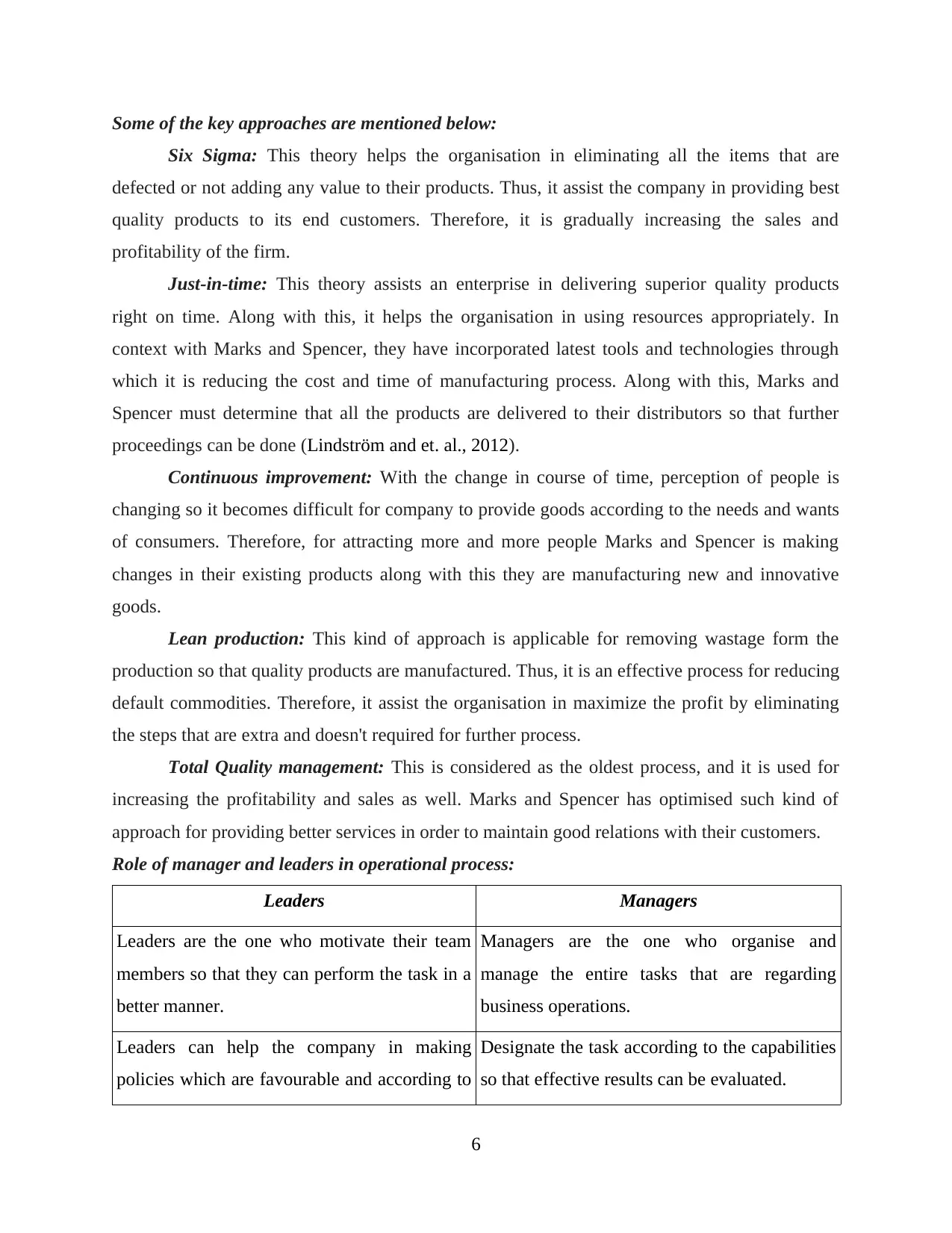
Some of the key approaches are mentioned below:
Six Sigma: This theory helps the organisation in eliminating all the items that are
defected or not adding any value to their products. Thus, it assist the company in providing best
quality products to its end customers. Therefore, it is gradually increasing the sales and
profitability of the firm.
Just-in-time: This theory assists an enterprise in delivering superior quality products
right on time. Along with this, it helps the organisation in using resources appropriately. In
context with Marks and Spencer, they have incorporated latest tools and technologies through
which it is reducing the cost and time of manufacturing process. Along with this, Marks and
Spencer must determine that all the products are delivered to their distributors so that further
proceedings can be done (Lindström and et. al., 2012).
Continuous improvement: With the change in course of time, perception of people is
changing so it becomes difficult for company to provide goods according to the needs and wants
of consumers. Therefore, for attracting more and more people Marks and Spencer is making
changes in their existing products along with this they are manufacturing new and innovative
goods.
Lean production: This kind of approach is applicable for removing wastage form the
production so that quality products are manufactured. Thus, it is an effective process for reducing
default commodities. Therefore, it assist the organisation in maximize the profit by eliminating
the steps that are extra and doesn't required for further process.
Total Quality management: This is considered as the oldest process, and it is used for
increasing the profitability and sales as well. Marks and Spencer has optimised such kind of
approach for providing better services in order to maintain good relations with their customers.
Role of manager and leaders in operational process:
Leaders Managers
Leaders are the one who motivate their team
members so that they can perform the task in a
better manner.
Managers are the one who organise and
manage the entire tasks that are regarding
business operations.
Leaders can help the company in making
policies which are favourable and according to
Designate the task according to the capabilities
so that effective results can be evaluated.
6
Six Sigma: This theory helps the organisation in eliminating all the items that are
defected or not adding any value to their products. Thus, it assist the company in providing best
quality products to its end customers. Therefore, it is gradually increasing the sales and
profitability of the firm.
Just-in-time: This theory assists an enterprise in delivering superior quality products
right on time. Along with this, it helps the organisation in using resources appropriately. In
context with Marks and Spencer, they have incorporated latest tools and technologies through
which it is reducing the cost and time of manufacturing process. Along with this, Marks and
Spencer must determine that all the products are delivered to their distributors so that further
proceedings can be done (Lindström and et. al., 2012).
Continuous improvement: With the change in course of time, perception of people is
changing so it becomes difficult for company to provide goods according to the needs and wants
of consumers. Therefore, for attracting more and more people Marks and Spencer is making
changes in their existing products along with this they are manufacturing new and innovative
goods.
Lean production: This kind of approach is applicable for removing wastage form the
production so that quality products are manufactured. Thus, it is an effective process for reducing
default commodities. Therefore, it assist the organisation in maximize the profit by eliminating
the steps that are extra and doesn't required for further process.
Total Quality management: This is considered as the oldest process, and it is used for
increasing the profitability and sales as well. Marks and Spencer has optimised such kind of
approach for providing better services in order to maintain good relations with their customers.
Role of manager and leaders in operational process:
Leaders Managers
Leaders are the one who motivate their team
members so that they can perform the task in a
better manner.
Managers are the one who organise and
manage the entire tasks that are regarding
business operations.
Leaders can help the company in making
policies which are favourable and according to
Designate the task according to the capabilities
so that effective results can be evaluated.
6
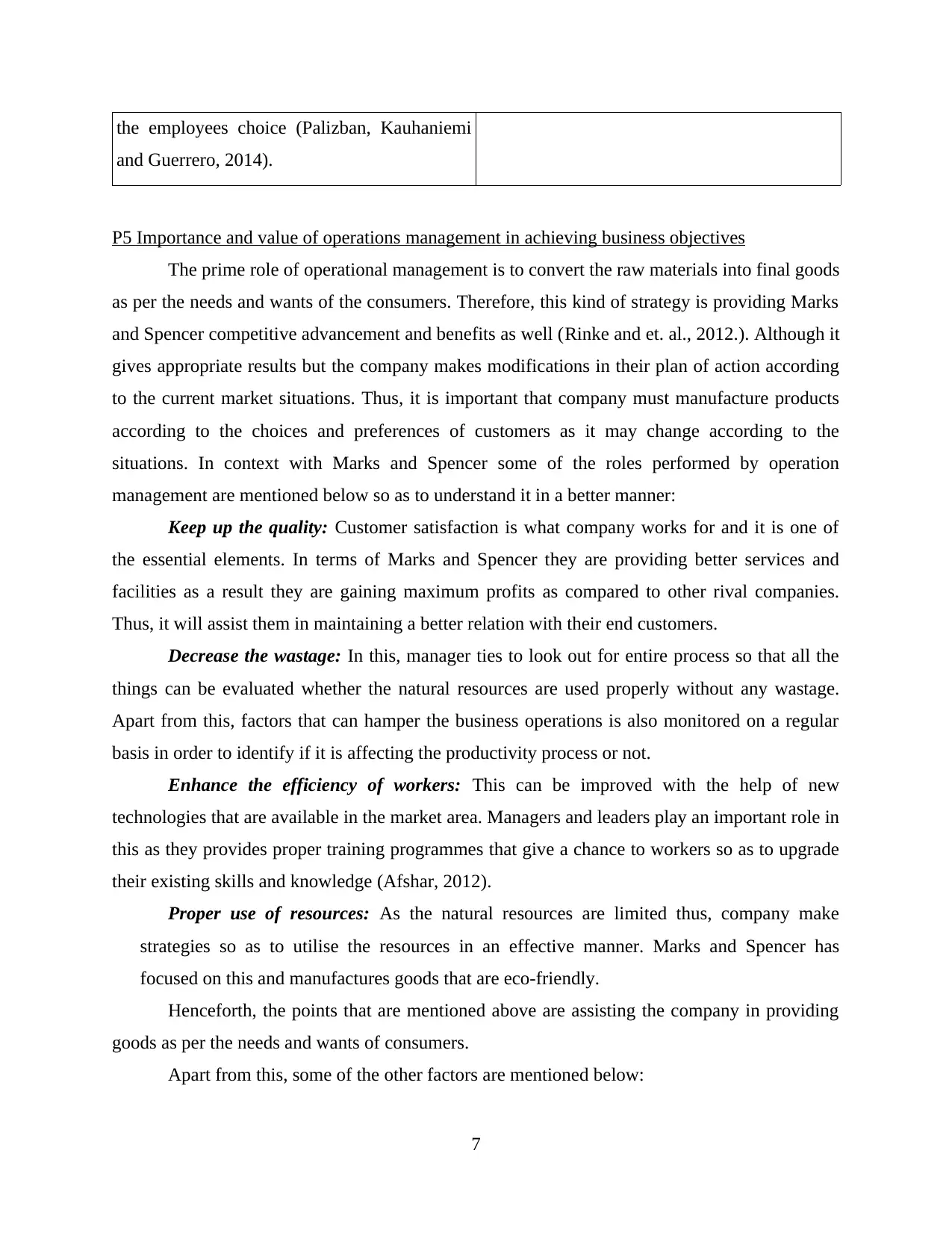
the employees choice (Palizban, Kauhaniemi
and Guerrero, 2014).
P5 Importance and value of operations management in achieving business objectives
The prime role of operational management is to convert the raw materials into final goods
as per the needs and wants of the consumers. Therefore, this kind of strategy is providing Marks
and Spencer competitive advancement and benefits as well (Rinke and et. al., 2012.). Although it
gives appropriate results but the company makes modifications in their plan of action according
to the current market situations. Thus, it is important that company must manufacture products
according to the choices and preferences of customers as it may change according to the
situations. In context with Marks and Spencer some of the roles performed by operation
management are mentioned below so as to understand it in a better manner:
Keep up the quality: Customer satisfaction is what company works for and it is one of
the essential elements. In terms of Marks and Spencer they are providing better services and
facilities as a result they are gaining maximum profits as compared to other rival companies.
Thus, it will assist them in maintaining a better relation with their end customers.
Decrease the wastage: In this, manager ties to look out for entire process so that all the
things can be evaluated whether the natural resources are used properly without any wastage.
Apart from this, factors that can hamper the business operations is also monitored on a regular
basis in order to identify if it is affecting the productivity process or not.
Enhance the efficiency of workers: This can be improved with the help of new
technologies that are available in the market area. Managers and leaders play an important role in
this as they provides proper training programmes that give a chance to workers so as to upgrade
their existing skills and knowledge (Afshar, 2012).
Proper use of resources: As the natural resources are limited thus, company make
strategies so as to utilise the resources in an effective manner. Marks and Spencer has
focused on this and manufactures goods that are eco-friendly.
Henceforth, the points that are mentioned above are assisting the company in providing
goods as per the needs and wants of consumers.
Apart from this, some of the other factors are mentioned below:
7
and Guerrero, 2014).
P5 Importance and value of operations management in achieving business objectives
The prime role of operational management is to convert the raw materials into final goods
as per the needs and wants of the consumers. Therefore, this kind of strategy is providing Marks
and Spencer competitive advancement and benefits as well (Rinke and et. al., 2012.). Although it
gives appropriate results but the company makes modifications in their plan of action according
to the current market situations. Thus, it is important that company must manufacture products
according to the choices and preferences of customers as it may change according to the
situations. In context with Marks and Spencer some of the roles performed by operation
management are mentioned below so as to understand it in a better manner:
Keep up the quality: Customer satisfaction is what company works for and it is one of
the essential elements. In terms of Marks and Spencer they are providing better services and
facilities as a result they are gaining maximum profits as compared to other rival companies.
Thus, it will assist them in maintaining a better relation with their end customers.
Decrease the wastage: In this, manager ties to look out for entire process so that all the
things can be evaluated whether the natural resources are used properly without any wastage.
Apart from this, factors that can hamper the business operations is also monitored on a regular
basis in order to identify if it is affecting the productivity process or not.
Enhance the efficiency of workers: This can be improved with the help of new
technologies that are available in the market area. Managers and leaders play an important role in
this as they provides proper training programmes that give a chance to workers so as to upgrade
their existing skills and knowledge (Afshar, 2012).
Proper use of resources: As the natural resources are limited thus, company make
strategies so as to utilise the resources in an effective manner. Marks and Spencer has
focused on this and manufactures goods that are eco-friendly.
Henceforth, the points that are mentioned above are assisting the company in providing
goods as per the needs and wants of consumers.
Apart from this, some of the other factors are mentioned below:
7
⊘ This is a preview!⊘
Do you want full access?
Subscribe today to unlock all pages.

Trusted by 1+ million students worldwide
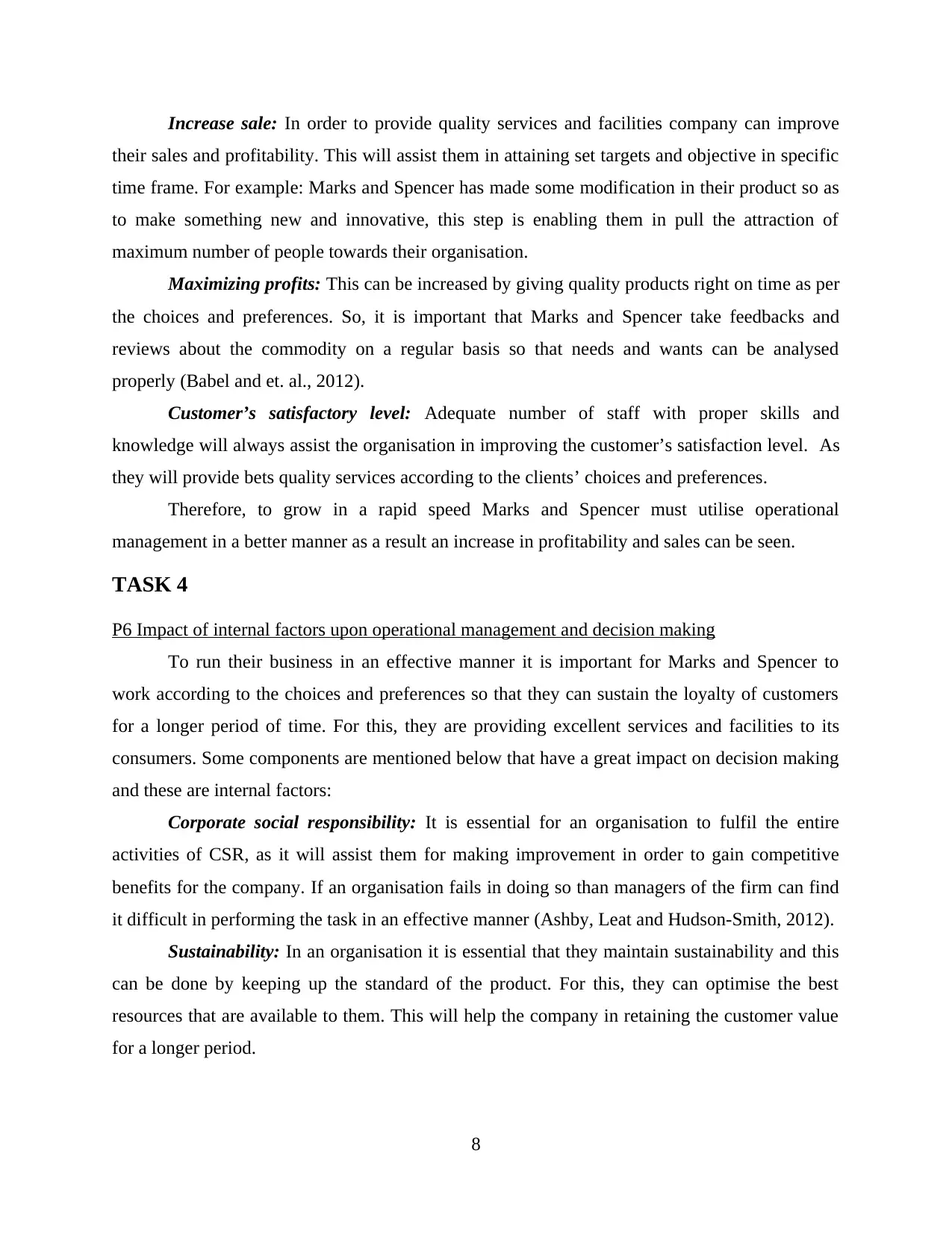
Increase sale: In order to provide quality services and facilities company can improve
their sales and profitability. This will assist them in attaining set targets and objective in specific
time frame. For example: Marks and Spencer has made some modification in their product so as
to make something new and innovative, this step is enabling them in pull the attraction of
maximum number of people towards their organisation.
Maximizing profits: This can be increased by giving quality products right on time as per
the choices and preferences. So, it is important that Marks and Spencer take feedbacks and
reviews about the commodity on a regular basis so that needs and wants can be analysed
properly (Babel and et. al., 2012).
Customer’s satisfactory level: Adequate number of staff with proper skills and
knowledge will always assist the organisation in improving the customer’s satisfaction level. As
they will provide bets quality services according to the clients’ choices and preferences.
Therefore, to grow in a rapid speed Marks and Spencer must utilise operational
management in a better manner as a result an increase in profitability and sales can be seen.
TASK 4
P6 Impact of internal factors upon operational management and decision making
To run their business in an effective manner it is important for Marks and Spencer to
work according to the choices and preferences so that they can sustain the loyalty of customers
for a longer period of time. For this, they are providing excellent services and facilities to its
consumers. Some components are mentioned below that have a great impact on decision making
and these are internal factors:
Corporate social responsibility: It is essential for an organisation to fulfil the entire
activities of CSR, as it will assist them for making improvement in order to gain competitive
benefits for the company. If an organisation fails in doing so than managers of the firm can find
it difficult in performing the task in an effective manner (Ashby, Leat and Hudson-Smith, 2012).
Sustainability: In an organisation it is essential that they maintain sustainability and this
can be done by keeping up the standard of the product. For this, they can optimise the best
resources that are available to them. This will help the company in retaining the customer value
for a longer period.
8
their sales and profitability. This will assist them in attaining set targets and objective in specific
time frame. For example: Marks and Spencer has made some modification in their product so as
to make something new and innovative, this step is enabling them in pull the attraction of
maximum number of people towards their organisation.
Maximizing profits: This can be increased by giving quality products right on time as per
the choices and preferences. So, it is important that Marks and Spencer take feedbacks and
reviews about the commodity on a regular basis so that needs and wants can be analysed
properly (Babel and et. al., 2012).
Customer’s satisfactory level: Adequate number of staff with proper skills and
knowledge will always assist the organisation in improving the customer’s satisfaction level. As
they will provide bets quality services according to the clients’ choices and preferences.
Therefore, to grow in a rapid speed Marks and Spencer must utilise operational
management in a better manner as a result an increase in profitability and sales can be seen.
TASK 4
P6 Impact of internal factors upon operational management and decision making
To run their business in an effective manner it is important for Marks and Spencer to
work according to the choices and preferences so that they can sustain the loyalty of customers
for a longer period of time. For this, they are providing excellent services and facilities to its
consumers. Some components are mentioned below that have a great impact on decision making
and these are internal factors:
Corporate social responsibility: It is essential for an organisation to fulfil the entire
activities of CSR, as it will assist them for making improvement in order to gain competitive
benefits for the company. If an organisation fails in doing so than managers of the firm can find
it difficult in performing the task in an effective manner (Ashby, Leat and Hudson-Smith, 2012).
Sustainability: In an organisation it is essential that they maintain sustainability and this
can be done by keeping up the standard of the product. For this, they can optimise the best
resources that are available to them. This will help the company in retaining the customer value
for a longer period.
8
Paraphrase This Document
Need a fresh take? Get an instant paraphrase of this document with our AI Paraphraser
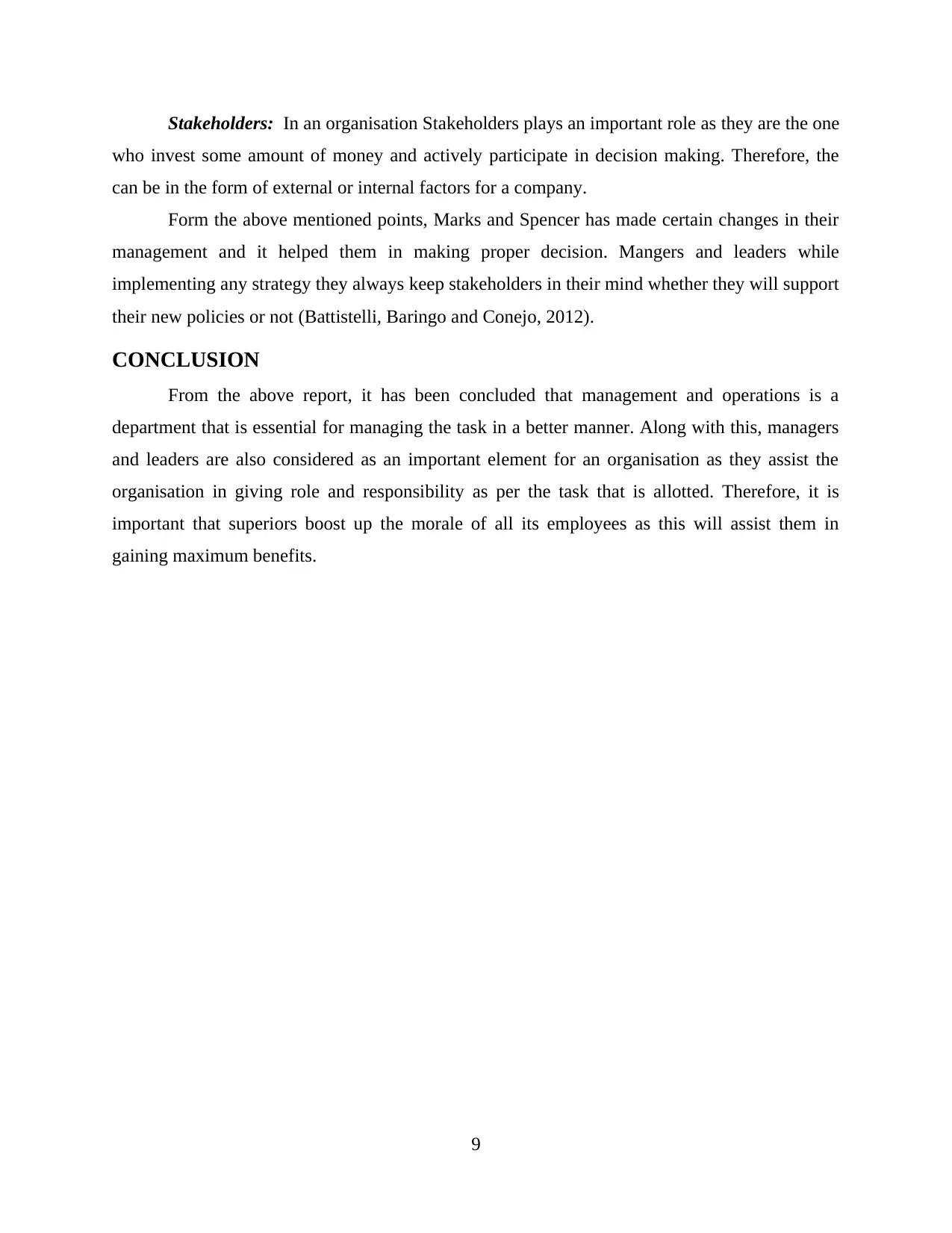
Stakeholders: In an organisation Stakeholders plays an important role as they are the one
who invest some amount of money and actively participate in decision making. Therefore, the
can be in the form of external or internal factors for a company.
Form the above mentioned points, Marks and Spencer has made certain changes in their
management and it helped them in making proper decision. Mangers and leaders while
implementing any strategy they always keep stakeholders in their mind whether they will support
their new policies or not (Battistelli, Baringo and Conejo, 2012).
CONCLUSION
From the above report, it has been concluded that management and operations is a
department that is essential for managing the task in a better manner. Along with this, managers
and leaders are also considered as an important element for an organisation as they assist the
organisation in giving role and responsibility as per the task that is allotted. Therefore, it is
important that superiors boost up the morale of all its employees as this will assist them in
gaining maximum benefits.
9
who invest some amount of money and actively participate in decision making. Therefore, the
can be in the form of external or internal factors for a company.
Form the above mentioned points, Marks and Spencer has made certain changes in their
management and it helped them in making proper decision. Mangers and leaders while
implementing any strategy they always keep stakeholders in their mind whether they will support
their new policies or not (Battistelli, Baringo and Conejo, 2012).
CONCLUSION
From the above report, it has been concluded that management and operations is a
department that is essential for managing the task in a better manner. Along with this, managers
and leaders are also considered as an important element for an organisation as they assist the
organisation in giving role and responsibility as per the task that is allotted. Therefore, it is
important that superiors boost up the morale of all its employees as this will assist them in
gaining maximum benefits.
9
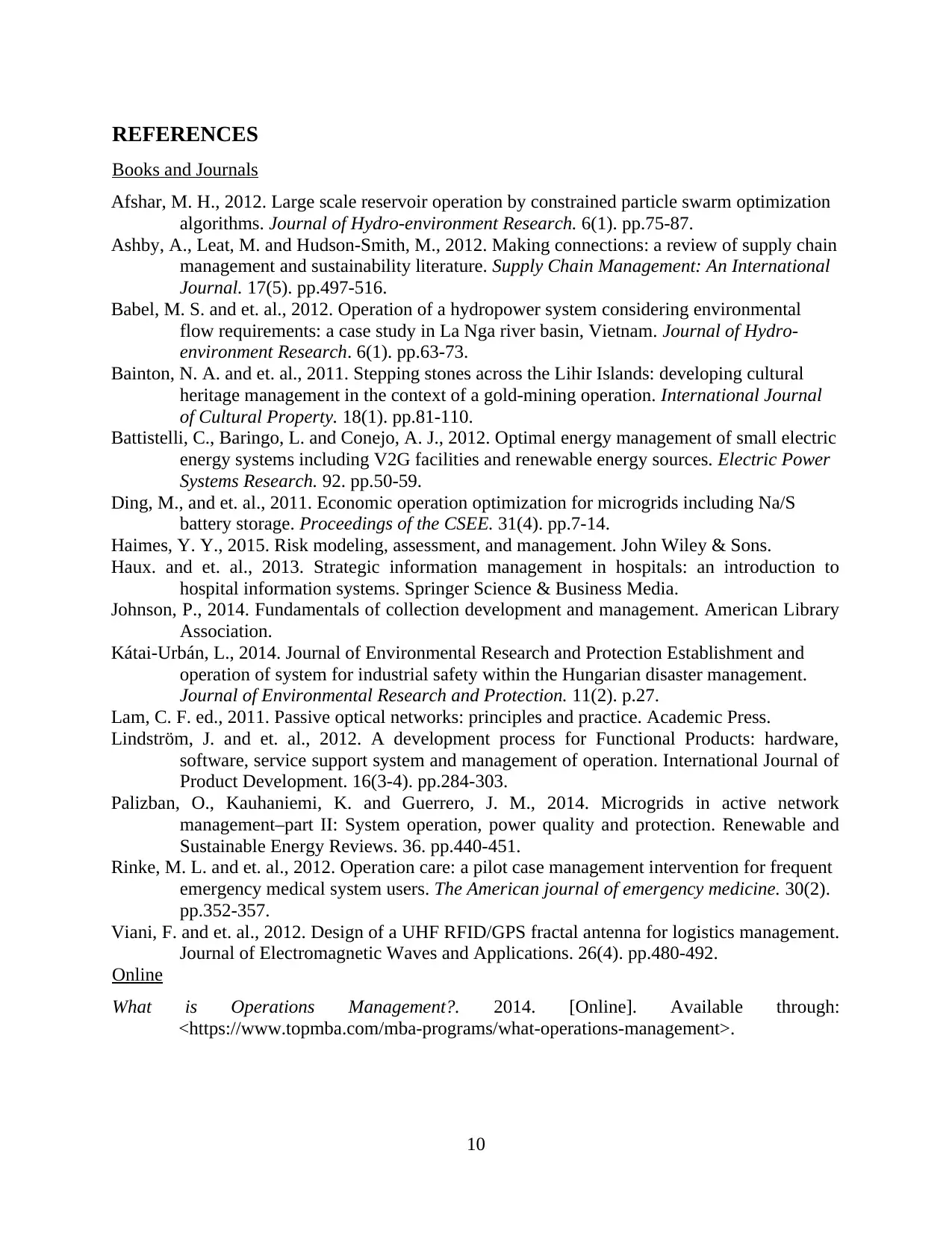
REFERENCES
Books and Journals
Afshar, M. H., 2012. Large scale reservoir operation by constrained particle swarm optimization
algorithms. Journal of Hydro-environment Research. 6(1). pp.75-87.
Ashby, A., Leat, M. and Hudson-Smith, M., 2012. Making connections: a review of supply chain
management and sustainability literature. Supply Chain Management: An International
Journal. 17(5). pp.497-516.
Babel, M. S. and et. al., 2012. Operation of a hydropower system considering environmental
flow requirements: a case study in La Nga river basin, Vietnam. Journal of Hydro-
environment Research. 6(1). pp.63-73.
Bainton, N. A. and et. al., 2011. Stepping stones across the Lihir Islands: developing cultural
heritage management in the context of a gold-mining operation. International Journal
of Cultural Property. 18(1). pp.81-110.
Battistelli, C., Baringo, L. and Conejo, A. J., 2012. Optimal energy management of small electric
energy systems including V2G facilities and renewable energy sources. Electric Power
Systems Research. 92. pp.50-59.
Ding, M., and et. al., 2011. Economic operation optimization for microgrids including Na/S
battery storage. Proceedings of the CSEE. 31(4). pp.7-14.
Haimes, Y. Y., 2015. Risk modeling, assessment, and management. John Wiley & Sons.
Haux. and et. al., 2013. Strategic information management in hospitals: an introduction to
hospital information systems. Springer Science & Business Media.
Johnson, P., 2014. Fundamentals of collection development and management. American Library
Association.
Kátai-Urbán, L., 2014. Journal of Environmental Research and Protection Establishment and
operation of system for industrial safety within the Hungarian disaster management.
Journal of Environmental Research and Protection. 11(2). p.27.
Lam, C. F. ed., 2011. Passive optical networks: principles and practice. Academic Press.
Lindström, J. and et. al., 2012. A development process for Functional Products: hardware,
software, service support system and management of operation. International Journal of
Product Development. 16(3-4). pp.284-303.
Palizban, O., Kauhaniemi, K. and Guerrero, J. M., 2014. Microgrids in active network
management–part II: System operation, power quality and protection. Renewable and
Sustainable Energy Reviews. 36. pp.440-451.
Rinke, M. L. and et. al., 2012. Operation care: a pilot case management intervention for frequent
emergency medical system users. The American journal of emergency medicine. 30(2).
pp.352-357.
Viani, F. and et. al., 2012. Design of a UHF RFID/GPS fractal antenna for logistics management.
Journal of Electromagnetic Waves and Applications. 26(4). pp.480-492.
Online
What is Operations Management?. 2014. [Online]. Available through:
<https://www.topmba.com/mba-programs/what-operations-management>.
10
Books and Journals
Afshar, M. H., 2012. Large scale reservoir operation by constrained particle swarm optimization
algorithms. Journal of Hydro-environment Research. 6(1). pp.75-87.
Ashby, A., Leat, M. and Hudson-Smith, M., 2012. Making connections: a review of supply chain
management and sustainability literature. Supply Chain Management: An International
Journal. 17(5). pp.497-516.
Babel, M. S. and et. al., 2012. Operation of a hydropower system considering environmental
flow requirements: a case study in La Nga river basin, Vietnam. Journal of Hydro-
environment Research. 6(1). pp.63-73.
Bainton, N. A. and et. al., 2011. Stepping stones across the Lihir Islands: developing cultural
heritage management in the context of a gold-mining operation. International Journal
of Cultural Property. 18(1). pp.81-110.
Battistelli, C., Baringo, L. and Conejo, A. J., 2012. Optimal energy management of small electric
energy systems including V2G facilities and renewable energy sources. Electric Power
Systems Research. 92. pp.50-59.
Ding, M., and et. al., 2011. Economic operation optimization for microgrids including Na/S
battery storage. Proceedings of the CSEE. 31(4). pp.7-14.
Haimes, Y. Y., 2015. Risk modeling, assessment, and management. John Wiley & Sons.
Haux. and et. al., 2013. Strategic information management in hospitals: an introduction to
hospital information systems. Springer Science & Business Media.
Johnson, P., 2014. Fundamentals of collection development and management. American Library
Association.
Kátai-Urbán, L., 2014. Journal of Environmental Research and Protection Establishment and
operation of system for industrial safety within the Hungarian disaster management.
Journal of Environmental Research and Protection. 11(2). p.27.
Lam, C. F. ed., 2011. Passive optical networks: principles and practice. Academic Press.
Lindström, J. and et. al., 2012. A development process for Functional Products: hardware,
software, service support system and management of operation. International Journal of
Product Development. 16(3-4). pp.284-303.
Palizban, O., Kauhaniemi, K. and Guerrero, J. M., 2014. Microgrids in active network
management–part II: System operation, power quality and protection. Renewable and
Sustainable Energy Reviews. 36. pp.440-451.
Rinke, M. L. and et. al., 2012. Operation care: a pilot case management intervention for frequent
emergency medical system users. The American journal of emergency medicine. 30(2).
pp.352-357.
Viani, F. and et. al., 2012. Design of a UHF RFID/GPS fractal antenna for logistics management.
Journal of Electromagnetic Waves and Applications. 26(4). pp.480-492.
Online
What is Operations Management?. 2014. [Online]. Available through:
<https://www.topmba.com/mba-programs/what-operations-management>.
10
⊘ This is a preview!⊘
Do you want full access?
Subscribe today to unlock all pages.

Trusted by 1+ million students worldwide
1 out of 13
Related Documents
Your All-in-One AI-Powered Toolkit for Academic Success.
+13062052269
info@desklib.com
Available 24*7 on WhatsApp / Email
![[object Object]](/_next/static/media/star-bottom.7253800d.svg)
Unlock your academic potential
Copyright © 2020–2025 A2Z Services. All Rights Reserved. Developed and managed by ZUCOL.





